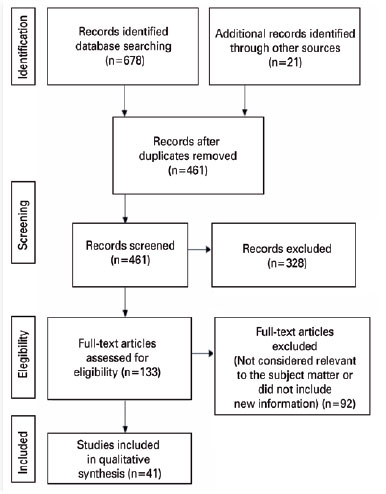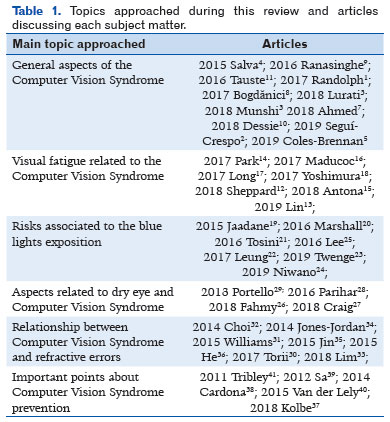Alex Andrade Maciel1; Ridson Guilherme Parente de Aguiar1; Juliana de Lucena Martins Ferreira2; João Crispim Moraes Lima Ribeiro2,3
DOI: 10.17545/eOftalmo/2022.0008
ABSTRACT
Technological advances in computing field and the facilitation of Internet access in the globalized world have revolutionized the way people work and communicate. However, these advances do not bring only benefits. These changes are affecting the social interaction and the mental and physical health of some individuals. As an example, the Computer Vision Syndrome gradually changed from a health problem in the workplace to a public health problem, with consequences on the individual’s quality. This article reviews recent studies about the Computer Vision Syndrome and its characteristics, social impact and prevention.
Keywords: Computer vision syndrome; Digital eye fatigue; Visual fatigue; Blue light; Phototoxicity.
RESUMO
Os avanços tecnológicos no campo da computação e a facilitação do acesso à Internet no mundo globalizado revolucionaram a forma como as pessoas trabalham e se comunicam. No entanto, esses avanços não trazem apenas benefícios. Essas mudanças estão afetando a interação social e a saúde mental e física de alguns indivíduos. A título de exemplo, a síndrome da visão do computador passou gradualmente de um problema de saúde no local de trabalho para um problema de saúde pública, com consequências na qualidade de vida do indivíduo. Este artigo revisa estudos recentes sobre a Síndrome da Visão do Computador e suas características, impacto social e prevenção.
Palavras-chave: Síndrome da visão do computador; Fadiga ocular digital; fadiga visual; Luz azul; Fototoxicidade.
INTRODUCTION
Currently, technological advances in the area of computing and the facilitation of Internet access in the globalized world, allow workers to be more productive when it comes to online information1. However, they tend to spend more time looking at electronic devices with visual displays, such as computers, laptops, smartphones, tablets, and even smartwatches, contributing to the emergence of Computer Vision Syndrome (CVS)2. In addition, children, young people and the elderly are also affected when they spend many hours a day using electronic devices for entertainment, studying and interacting in social networks3. In this perspective, more than 80% of a person’s learning is mediated by the eyes, demonstrating the importance of visual health4. Beyond that, the human being has never spent so much time in front of digital devices, thus several visual problems are occurring due to this practice; therefore, the Computer Vision Syndrome (CVS) has been recognized as a health problem for more than 20 years. The terms digital eyestrain and visual fatigue can also be used in this situation5. This condition is characterized by severe eye discomfort linked to the use of digital devices, including blurring, photophobia, dry eye, headache, and eye fatigue6. Thus, this article intends to contribute to the knowledge of academics and health professionals, in addition, to complementing existing publications on the subject. The authors aim to expose the Computer Vision Syndrome as well as explain the risk factors and ways of prevention.
METHODS
We utilized the Medline (PubMed) database for all articles published between 2013 and 2019 to perform a review of the literature, with the addition of 21 other articles that we considered relevant. Descriptors included were “Digital Eye Strain”; “Computer Vision Syndrome”; “Blue Light” AND “Phototoxity; and “Refractive error” AND “Computer”.
During October 2018 to June 2019, four researchers independently analyzed the filtered data, according to a customized protocol. The inclusion criteria included achieve the approval of more than 50% of the researchers and articles related to Computer Vision Syndrome. Duplicates, articles considered not relevant to the subject matter and articles that did not discuss Computer Vision Syndrome or its relevant associations were among the exclusion criteria.
RESULTS
Primary search pointed a total of 678 articles when combining the descriptors. After addition of 21 relevant articles and duplicates removal, 461 articles remained. After screening and eligibility filtering, 41 articles were included in this review. A PRISMA (Preferred Reporting Items for Systematic Reviews and Meta-Analyses) flow diagram was included to illustrate each phase of this review (Figure 1).

The evaluated outcomes were finally included into the following categories in Discussion: “Computer Vision Syndrome”, “Visual fatigue”, “Blue light”, “Dry eye”, “Refractive errors” and “Prevention” (Table 1).

DISCUSSION
Computer vision syndrome
The main occupational risk of the 21st century and its symptoms affect almost 70% of all computer users, with the main symptoms: digital eyestrain, dry and irritated eyes, eye tiredness/fatigue, blurred vision, red eyes, burning eyes, excessive tearing, double vision, headache, sensitivity to light/brightness, slowness in changing focus and changes in color perception7 (Table 2). Symptoms can be aggravated in situations with poor ambient lighting (favoring only the brightness of the screen of a digital device), excessive brightness of the display screen, reflection on the screen, inadequate viewing due to distances and poor posture, or a combination of these factors8. CVS affects around 60 million people around the world, resulting in a reduction in the quality of life of those who suffer from this condition9.

In this perspective, CVS can generate several symptoms in which they are not directly related to the eyes, such as stress, irritability, increased nervousness, fatigue, and drowsiness. The texts and figures on the screens of digital devices are created by variations of small points of light known as pixels, which are brighter in the center and decrease in intensity towards the edges, making it difficult for the human eye to focus10. Also, users of contact lenses who use the computer for more than 6 hours a day are more likely to develop CVS than those who do not wear contact lenses and use the computer for the same period, with a prevalence of 65% vs. 50% (OR=4.85; 95% CI) 1.25-18.80; p=0.02)11.
Visual fatigue
Visual discomfort induced by digital mobile devices (Computers, smartphones, notebooks, smartwatches etc.) is a symptom that can be associated with Computer Vision Syndrome (CVS)12. Glare-free displays can relieve symptoms of discomfort eye piece and improve visual performance13. However, when using these devices indefinitely, visual fatigue can be induced even if the devices are equipped with automatic brightness balance technology during display14.
Thus, even in conditions of similar environments and with healthy individuals, prolonged reading on a smartphone is more harmful than the printed reading concerning visual fatigue and worsens even more when this practice is performed in an environment with little or no lighting15. Individuals who substitute printed reading for reading on e-readers for an extended period are 4.9 times more likely to report severe visual fatigue (95% CI [1.4 - 16.9]), even those who do not have clinical characteristics that can predispose this condition16.
Besides, the viewing distance (distance between the head and the hand holding the smartphone) during a 60 min period of reading a text on a smartphone tends to decrease. In this case, the symptoms of eye fatigue are more reported after this practice, even in individuals with normal visual acuity and without accommodative or binocular visual disturbances17. Consequently, when using a smartphone before sleeping in the supine position, the viewing distance tends to decrease normally as a matter of comfort. This correlates with worsening sleep status and sleep efficiency, as the blue light from digital device monitors directly influences the reduction of melatonin secretion, which is one of the causes for a lower quality of sleep18.
Blue light
In this perspective, the damage to the retina induced by light depends on the intensity of the radiation, the wavelength of the radiation, and the exposure time19. The blue light range is between 400-490 nm, which can cause damage to the photoreceptors, where the highest risk of damage to the retina is associated with wavelengths with a peak of 441 nm. Contributing to the appearance of pathologies such as cataracts and macular degeneration (depending on the period and exposure), this being the third largest cause of blindness worldwide20.
Man evolved under sunlight, demonstrating that blue light provides changes in the physiology of the circadian cycle21. In this way, daytime exposure to blue light regulates the internal circadian biological clock, stimulating the brain to stay awake during the day, inhibiting the secretion of melatonin22. Thus, the use of electronic devices, over a long period, tends to decrease hours of sleep, and can affect any age23.
Blue light can harm cells on the eye surface, depending on the intensity and time of exposure24. Excessive exposure to blue light with short wavelengths can induce oxidative damage and apoptosis to the cornea25. In one experiment, phototoxicity caused by prolonged exposure to blue light was mitigated in an experiment by 10.6% to 23.6% by blue filter lenses. However, the use of blue light filters also decreased scotopic sensitivity by 2.4% to 9.6% and melatonin suppression by 5.8% to 15.0%, more than 70% of the participants in this experiment did not had optical changes detected22.
Dry eye
Dry eye syndrome is a common disorder, comprising around 25% of the causes of patient visits to the ophthalmology office, affecting women more than men, especially after menopause26. Thus, dry eye syndrome has a multifactorial nature and is characterized as a disease whose central pathophysiological concept is the loss of homeostasis of the tear film27.
Its main symptoms are eye discomforts, such as burning, watering, foreign body sensation, and eye fatigue, being reported as some of the symptoms of Computer Vision Syndrome (CVS)28. In addition, CVS is reported to produce significant symptoms in approximately 40% of office workers, and around 15% and 30% of the general population (depending on the diagnostic criteria adopted) have dry eye symptoms29.
Refractive Errors
Myopia is the most common refractive error caused by stretching the axial length of the eyeball30. Multiple factors are involved in the development of myopia. Both genetics and the environment play an important role in the development and progression of myopia31. It is known that the lower participation in outdoor activities is a significant environmental risk factor for myopia, as well as the low serum dose of 25-hydroxyvitamin D32,33.
Regarding the genetic contribution, heritability is estimated at 0.77 to 0.94 in twins34. However, while a substantial proportion of myopia cases can be explained by inheritance, environmental etiology is extremely important. There is a consensus that genes can determine susceptibility to environmental factors, to the point that adding 40 minutes outdoors, when comparing the usual activity in children aged six years, it can result in a reduction in the incidence rate in myopia in the following three years35,36.
Prevention
Adequate lighting in the work or study environment can improve visual comfort and performance. It is recommended that the reduction of the monitor’s brightness and contrast and, if possible, the light from the window (solar lighting) should be on the side, helping to illuminate the environment. The use of progressive computer-specific lenses reduces the perception of CVS symptoms37,38.
It is interesting to rest the eyes during prolonged use of the computer and impose a time limit in front of a computer, when possible39. Moreover, blue light blocking glasses have a significant effect in decreasing the suppression effect of melatonin caused by the illumination of LED screens40. After 2 hours of continuous use of the computer, users should rest their eyes for 15 minutes. In addition, it is necessary to keep the screen of the digital device always clean and focused. Regular eye exams are essential to maintain visual health and prevent CVS41.
Computer vision syndrome is already considered a public health problem, despite being new and still poorly understood. Currently, it is not feasible to go back technologically and exclude electronic screens from modern daily life. Therefore, avoiding the risk factors mentioned throughout the article and periodically having eye consultations can be a good alternative for the prevention of this syndrome. Further studies are needed to better address this issue.
REFERENCES
1. Randolph SA. Computer Vision Syndrome. Workplace Health Saf. 2017;65(7):328.
2. Seguí-Crespo MDM, Cantó Sancho N, Ronda E, Colombo R, Porru S, Carta A. Translation and cultural adaptation of the Computer Vision Syndrome Questionnaire (CVS-Q) into Italian. Med Lav. 2019;110(1):37-45.
3. Lurati AR. Computer Vision Syndrome: Implications for the Occupational Health Nurse. Workplace Health Saf. 2018;66(2):56-60.
4. Salve UR. Vision-related problems among the workers engaged in jewellery manufacturing. Indian J Occup Environ Med. 2015; 19(1):30-5.
5. Coles-Brennan C, Sulley A, Young G. Management of digital eyestrain. Clin Exp Optom. 2019;102(1):18-29.
6. Munshi S, Varghese A, Dhar-Munshi S. Computer vision syndrome-A common cause of unexplained visual symptoms in the modern era. Int J Clin Pract. 2017 Jul;71(7). doi: 10.1111/ijcp.12962.
7. Ahmed SF, McDermott KC, Burge WK, Ahmed IIK, Varma DK3, Liao YJ, et al. Visual function, digital behavior and the vision performance index. Clin Ophthalmol. 2018 Dec 10;12: 2553-2561.
8. Bogdănici CM, Săndulache DE, Nechita CA. Eye sight quality and Computer Vision Syndrome. Rom J Ophthalmol. 2017;61(2):112-6.
9. Ranasinghe P, Wathurapatha WS, Perera YS, Lamabadusuriya DA, Kulatunga S, Jayawardana N, et al. Computer vision syndrome among computer office workers in a developing country: an evaluation of prevalence and risk factors. BMC Res Notes. 2016;9(1):150.
10. Dessie A, Adane F, Nega A, Wami SD, Chercos DH. Computer Vision Syndrome and Associated Factors among Computer Users in Debre Tabor Town, Northwest Ethiopia. J Environ Public Health. 2018 Sep 16;2018:4107590.
11. Tauste A, Ronda E, Molina MJ, Seguí M. Effect of contact lens use on Computer Vision Syndrome. Ophthalmic Physiol Opt. 2016;36(2):112-9.
12. Sheppard AL, Wolffsohn JS. Digital eyestrain: prevalence, measurement and a melioration. BMJ Open Ophthalmol. 2018;3(1):e000146.
13. Lin CW, Yeh FM, Wu BW, Yang CH. The effects of reflected glare and visual field lighting on computer vision syndrome. Clin Exp Optom. 2019 Sep;102(5):513-20.
14. Park YH, An CM, Moon SJ. Effects of visual fatigue caused by smartphones on balance function in healthy adults. J Phys Ther Sci. 2017;29(2):221-3.
15. Antona B, Barrio AR, Gascó A, Pinar A, González-Pérez M, Puell MC. Symptoms associated with reading from a smartphone in conditions of light and dark. Appl Ergon. 2018 Apr; 68:12-7.
16. Maducdoc MM, Haider A, Nalbandian A, Youm JH, Morgan PV, Crow RW. Visual consequences of electronic reader use: a pilot study. Int Oftalmol. 2017;37(2):433-9.
17. Long J, Cheung R, Duong S, Paynter R, Asper L. Viewing distance and eyes train symptoms with prolonged viewing of smartphones. Clin Exp Optom. 2017;100(2):133-7.
18. Yoshimura M, Kitazawa M, Maeda Y, Mimura M, Tsubota K, Kishimoto T. Smartphone viewing distance and sleep: an experimental study utilizing motion capture technology. Nat Sci Sleep. 2017 Mar 8;9:59-65.
19. Jaadane I, Boulenguez P, Chahory S, Carré S, Savoldelli M, Jonet L, et al. Retinal damage induced by commercial light emitting diodes (LEDs). Free Radic Biol Med. 2015 Jul;84:373-84.
20. Marshall J. Light in man’s environment. Eye (Lond). 2016;30(2): 211-4.
21. Tosini G, Ferguson I, Tsubota K. Effects of blue light on the circadian system and eye physiology. Mol Vis. 2016 Jan;22:61-72.
22. Leung TW, Li RW, Kee CS. Blue-Light Filtering Spectacle Lenses: Optical and Clinical Performances. PLoSOne. 2017;12(1): e0169114.
23. Twenge JM, Hisler GC, Krizan Z. Associations between screen time and sleep duration are primarily driven by portable electronic devices: evidence from a population-based study of U.S. children ages 0-17. Sleep Med. 2019 Apr;56:211-218.
24. Niwano Y, Iwasawa A, Tsubota K, Ayaki M, Negishi K. Protective effects of blue light-blocking shades on photo toxicity in human ocular surface cells. BMJ Open Ophthalmol. 2019;4(1): e000217.
25. Lee HS, Cui L, Li Y, Choi JS, Choi JH, Li Z, Kim GE, et al. Influence of Light Emitting Diode-Derived Blue Light Overexposure on Mouse Ocular Surface. PLoSOne. 2016;11(8):e0161041.
26. Fahmy RM, Aldarwesh A. Correlation between dry eye and refractive error in Saudi young adults using noninvasive Keratograph 4. Indian J Ophthalmol. 2018;66(5):653-6.
27. Craig JP, Nichols KK, Akpek EK, Caffery B, Dua HS, Joo CK. TFOS DEWS II Definition and Classification Report. Ocul Surf. 2017;15(3):276-83.
28. Parihar JKS, Jain VK, Chaturvedi P, Kaushik J, Jain G, Parihar AKS. Computer and visual display terminals (VDT) vision syndrome (CVDTS). Med J Armed Forces India. 2016;72(3):270-6.
29. Portello JK, Rosenfield M, Chu CA. Blink rate, incomplete blinks and computer vision syndrome. Optom Vis Sci. 2013;90(5):482-7.
30. Torii H, Kurihara T, Seko Y, Negishi K, Ohnuma K, Inaba T, et al. Violet Light Exposure Can Be a Preventive Strategy Against Myopia Progression. EBioMedicine. 2017 Feb;15:210-9.
31. Williams KM, Bertelsen G, Cumberland P, Wolfram C, Verhoeven VJ, Anastasopoulos E, Buitendijk GHS, Cougnard-Grégoire A, Creuzot-Garcher C, Erke MG, Hogg R, Höhn R, Hysi P. Khawaja AP, Korobelnik JF, Ried J, Vingerling JR, Bron A, Dartigues JF, Fletcher A, Hofman A, Kuijpers RWAM, Luben RN, Oxele K, Topouzis F, von Hanno T, Mirshahi A, Foster PJ, van Duijn CM, Pfeiffer N, Delcourt C, Klaver CCW, Rahi J, Hammond CJ, European Eye Epidemiology (E(3)) Consortium. Increasing Prevalence of Myopia in Europe and the Impact of Education. Ophthalmology. 2015;122(7):1489-97.
32. Choi JA, Han K, Park YM, La TY. Low serum 25-hydroxyvitamin D is associated with myopia in Korean adolescents. Invest Ophthalmol Vis Sci. 2014;55(4):2041-7.
33. Lim DH, Han J, Chung TY, Kang S, Yim HW. The high prevalence of myopia in Korean children with influence of parental refractive errors: The 2008-2012 Korean National Health and Nutrition Examination Survey. PLoSOne. 201813(11):e0207690.
34. Jones-Jordan LA, Sinnott LT, Graham ND, Cotter SA, Kleinstein RN, Manny RE. The contributions of near work and outdoor activity to the correlation between siblings in the Collaborative Longitudinal Evaluation of Ethnicity and Refractive Error (CLEERE) Study. Invest Ophthalmol Vis Sci. 2014;55(10):6333-9.
35. Jin JX, Hua WJ, Jiang X, Wu XY, Yang JW, Gao GP, et al. Effect of outdoor activity on myopia onset and progression in school-aged children in Northeast China: the Sujiatun Eye Care Study. BMC Ophthalmol. 2015 Jul 9;15:73.
36. He M, Xiang F, Zeng Y, Mai J, Chen Q, Zhang J, Smith W, Rose K, et al. Effectof Time Spent Outdoors at School on the Development of Myopia Among Children in China: A Randomized Clinical Trial. JAMA. 2015;314(11):1142-8.
37. Kolbe O, Degle S. Presbyopic Personal Computer Work: A Comparison of Progressive Addition Lenses for General Purpose and Personal Computer Work. Optom Vis Sci. 2018;95(11):1046-53.
38. Cardona G, Gómez M, Quevedo L, Gispets J. Effects of transient blur and VDT screen luminance changes on eye blink rate. Cont Lens Anterior Eye. 2014;37(5):363-7.
39. Sa EC, Ferreira Júnior M, Rocha LE. Risk factors for computer visual syndrome (CVS) among operators of two call centers in São Paulo, Brazil. Work. 2012; 41 Suppl 1:3568-74.
40. Van der Lely S, Frey S, Garbazza C, Wirz-Justice A, Jenni OG, Steiner R, et al. Blue blocker glasses as a countermeasure for alerting effects of evening light-emitting diode screen exposure in male teenagers. J Adolesc Health. 2015;56(1):113-9.
41. Tribley J, McClain S, Karbasi A, Kaldenberg J. Tips for computer vision syndrome relief and prevention. Work. 2011;39(1):85-7.
AUTHOR’S INFORMATION



Funding: No specific financial support was available for this study
Conflict of interest: None of the authors have any potential conflict of interest to disclose
Received on:
June 1, 2022.
Accepted on:
July 3, 2022.